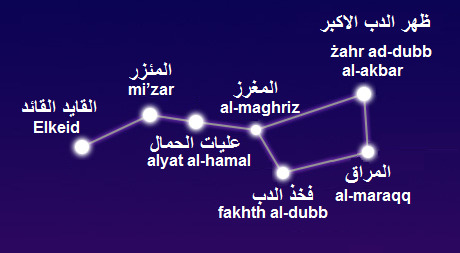cinehamal
22 posts
sideblog for lenen shit… header by kassabakeki on twitter
Don't wanna be here? Send us removal request.
Text
CW: ABUSE, VIOLENCE
CONTAINS MAJOR HEADCANONS FOR PRE-CANON EVENTS
Soil Not My Love [1/3]

























14 notes
·
View notes
Text

I've been looking at Suzumi star pages (particularly the arabic ones) and getting some Symbolism Revelations™ this evening that people may enjoy as food for thought.
Starting with the most lore-related one, Benny's name is often theorized to come from Benetnasch, the first star in the Big Dipper constellation. What nobody tells you however is that benny's star is originally called Alkaid, "the leader". Benetnasch comes from banaatunna'ash (Arabic; "بنات نعش", "the mourning maidens" lit. "Daughters of the bier") and is the arabic name of the big dipper constellation. A bier is a stand on which a corpse, coffin, or casket containing a corpse is placed to lie in state or to be carried to the grave. This relates to the original myth of Banaatunna'ash.
for the Bedouins of the Syrian desert, the Daughters of Nash accuse al-Jaday, i.e. Polaris, to have killed their father. But al-Farqadân [Ursa Minor] deem that the killer is not al-Jaday but Suhayl, and interpose between them and the North star. That is the reason why they are called al Hawâjzîn, “the Interposers”: they prevent the daughters from slaking their thirst for vengeance, and condemn them to turn indefinitely around the Pole.
From Our Arabic Heritage in the Celestial Vault.
Why this is interesting is because not only is Benny depicted to be the "leader" of the Suzumi collective– in the same constellation's naming origins (which influenced the names of Alkaid and Benetnasch), not only is Suzumi as a whole a being who seeks to sate their bloodlust for vengeance on Tsubakura, there also exists a Hamal among Alkaid's two companion stars, the other two mourning maidens.


The daughters of the bier, i.e. the mourning maidens, are the three stars of the handle of the Big Dipper, Alkaid, Mizar, and Alioth; while the four stars of the bowl, Megrez, Phecda, Merak, and Dubhe, are the bier.
From Medieval Islamic Astronomy.
Considering how Hamee often refers to themself as a maiden, this could point to a potential explanation as to why they do this.
Moving onto Hamee's star, Hamal – the current name of the star – (arabic; "حَمْل") refers to a little year-old lamb originally and not the ram as one may envision when looking at its relationship to Aries, this was an interpertation later introduced by the Greek. The star itself also is originally called "the horns of the lamb", specifically in reference to the tiny nubs you'd see on the head of a first-year fat tailed sheep, and is a similar case as with Benetnasch [name of constellation becomes the name of star because "wah arabic complicated" or something]. This exact type of sheep is also the one that would've been there for Jesus times if biblical allegories are your thing (parable of the lost sheep comes to mind). Also, in modern usage, the star is called "the headbutter/the headstrong", (Arabic; الناطح), so do with that what you will.
Arde has to have had the coolest one by far methinks, as Aldebaran is the only Suzumi star name that doesn't originally belong to a constellation and retains its original Arabic form plus it's the one with the most well-rounded mythology and cultural significance that just so happens to fit Arde well. To start, let's talk about the constellation right next to Aldebaran. Al-Thuriyya (Pleiades) has to be THE most famous constellation in Arab star mythology, being also related to Suhail (remember that guy?), and is also the reason of the name Aldebaran (Arabic; الدِبَران (full historical name; "الهادي الدِبَران")), meaning "The Follower" or "The Pursuing One", being given to the star right on its northwestern side.
According to an Arab legend from some point in the 7th century, Aldebaran was a poor and destitute person, while Al-Thuriyya was a beautiful and young girl. She impressed Aldebaran, so he decided to propose to her. He wanted someone to accompany him to the engagement ceremony, but he did not find anyone. So he went to the moon and asked him to try as much as he could to marry him to her, and the moon complied and went to her. But she refused, and after the moon pressed her, she said: “What should I do with this runt who has no money?”. The moon returned and told Aldebaran what had happened, but Aldebaran insisted on marrying her. He only owned sheep, so he took them all to Al-Thuriyya so that she would agree to marry him. The twenty sheep that Aldebaran led to the Pleiades are what came to be called “The Hyades,” which became the name of a star cluster that appears close to Aldebaran in the sky. The two stars near Aldebaran are his dogs, which he took with him and the sheep. As such, Aldebaran began to guide (follow) the Pleiades in the sky forever, along with his sheep, guiding them wherever they went. Thus, Aldebaran became a symbol of loyalty, while the Pleiades became a symbol of treachery. This loyalty was even mentioned in some Arabic proverbs: “More loyal than Al-Hadi (Al-Hadi Al-Dabran (Aldebaran)) and more treacherous than Al-Thuriyya (the Pleiades).”
Aldebaran also takes onto some mythology of its own as well, being a star whose rising is known to signal the beginning of the harshest periods of summer– Aldebaran became a star of ill omen to the Arabs of ancient times, even earning its own threatening rhymed prose;
اذا طلع الدبران, توقدت الحزان, وكرهت النيران, واستعرت الذبان, ويبست الغدران, ورمت بأنفسها حيث شاءت الصبيان.
When Aldebaran [the Follower] rises, the rugged lands abounding in jagged rocks burn, the fires are hated, the flies spread like fire, the pools of water left by torrents dry up, and the young children throw themselves wherever they desire.
From When the Follower Rises.
Seeing as Arde is the Suzumi who often keeps Hamee in check, holding them on a proverbial leash, them being "the follower" makes a lot of sense when you consider their canonical position. They also share similarities with Benetnasch, having two lesser stars associated with them (the "dogs") and being the brightest star of their respective constellations. Hamee is the only one who only has one lesser star, poor hambone.
Tl;dr I'm just sharing my silly region-locked star lore for everyone else to enjoy 😊 hope this unlocks as much Suzumi headcanons in your brain as it did mine
18 notes
·
View notes

















